Agora and Forum
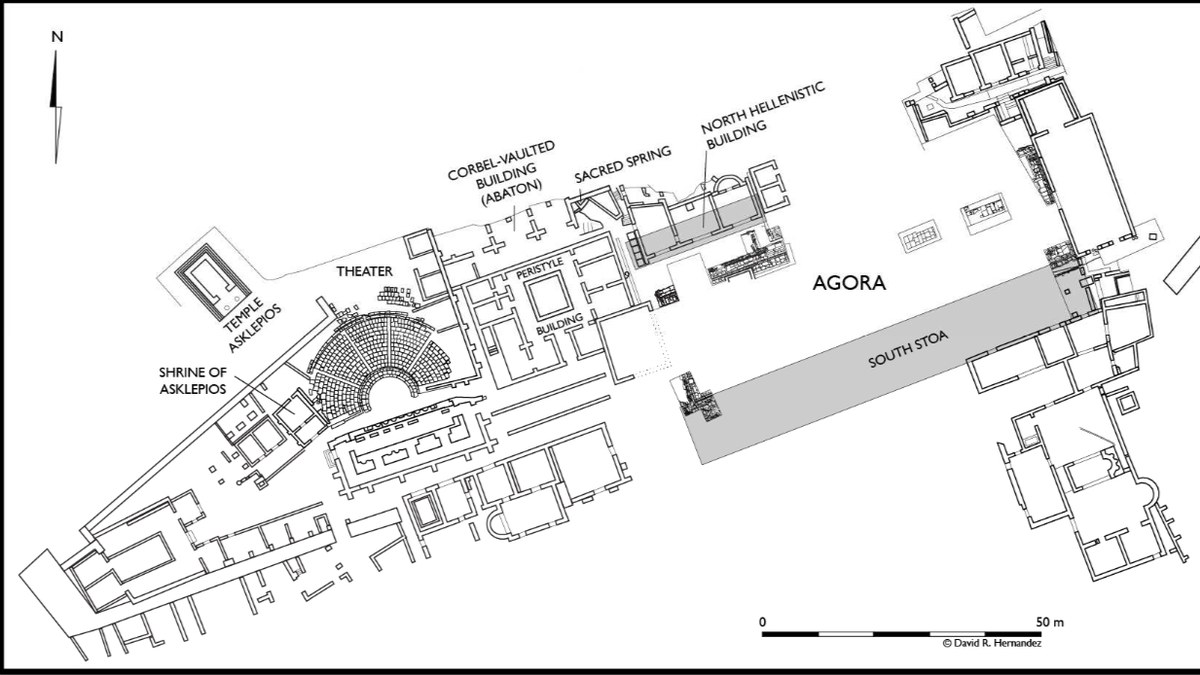
Plan from D. Hernandez and D. Çhondi, “The agora and the forum at Butrint: a new topography of the ancient urban center” in Lamboley, Perzhita, Skenderaj, L'Illyrie méridionale et l'Épire dans l'antiquité 6. Actes du 6e colloque international de Tirana (20 - 23 mai 2015), Paris, 2018, pp. 1-17
Greek Agora
The Agora is located on the east of the Sanctuary of Asclepius, in the same area where later the Roman Forum was built. It was defined by two buildings, the North Stoa and South Stoa (I and II), and covered a surface of 42 m wide and over 70 m long. The earliest traces can be dated to the half of the 2nd century BC. Little is known about its genesis, while there are more information about its life during the Augustan period.
The foundations of the North Stoa, built in large grey ashlar blocks, were found under the tripartite building, north west of the Forum. The remains are too scarce to really be useful in reconstructing its plan. It was over 25 m long and 4,5 m wide and it is located on the western part of the northern side of the Agora. It is believed that the columns and the Ionic capitals found on site belonged to it. Part of its spolia were used to build the Tripartite Building. The construction is dated between the second half of the 2nd century BC and the early 1st century BC, parallel to the construction of the sewage pipes located on its west side. At the end of the 1st century BC the North Stoa was demolished and replaced with the Tripartite Building.
Another long portico was found on the southeastern end of the Roman forum, approached by two steps supporting a colonnade. South Stoa I was longer than 72 m and it had at least 40 columns on the northern side, however it is not possible to determine the width of the building, since it was destroyed when the South Stoa II and the Forum were built. It seems that South Stoa I can be dated to the 1st century BC. The steps were later cut during the Forum construction in order to transform the stylobate of the building in the southern portico of the forum. These changes can also be seen in the impressions left for the columns on the top of the southern side, as well as in the signs of the lifting bosses, whose space coincides with the position of the columns. The alignment of the drain with the southeastern end of the South Stoa I also confirms that the construction of the Forum and the demolition of the building were contemporary.
The most ancient deposits contained ceramics from the 7th to the 5th century BC, probably fallen down the slopes of the acropolis, since the lower city did not exist in the Archaic and Classical periods.
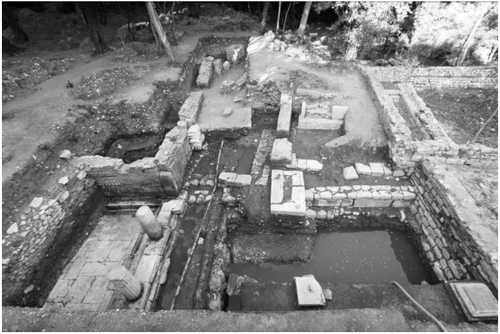
South Stoa II
During the construction of the Forum the colonnade and the steps of South Stoa I were adapted to create the stylobate for South Stoa II. It measured 72 x 11 m. The drain of the forum was partially demolished and blocked during the construction of South Stoa II.
Picture of the southern and eastern walls of South Stoa II from D. Hernandez and D. Çhondi, “The agora and the forum at Butrint: a new topography of the ancient urban center” in Lamboley, Perzhita, Skenderaj, L'Illyrie méridionale et l'Épire dans l'antiquité 6. Actes du 6e colloque international de Tirana (20 - 23 mai 2015), Paris, 2018, pp. 1-17
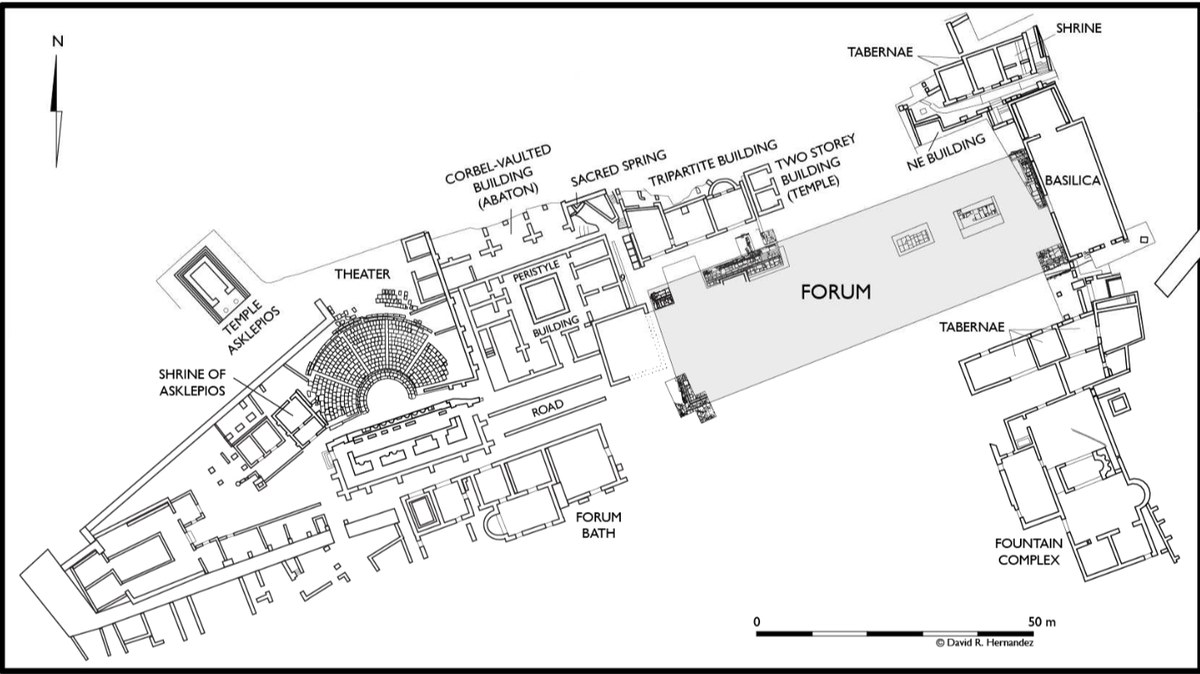
Plan from D. Hernandez and D. Çhondi, “The agora and the forum at Butrint: a new topography of the ancient urban center” in Lamboley, Perzhita, Skenderaj, L'Illyrie méridionale et l'Épire dans l'antiquité 6. Actes du 6e colloque international de Tirana (20 - 23 mai 2015), Paris, 2018, pp. 1-17
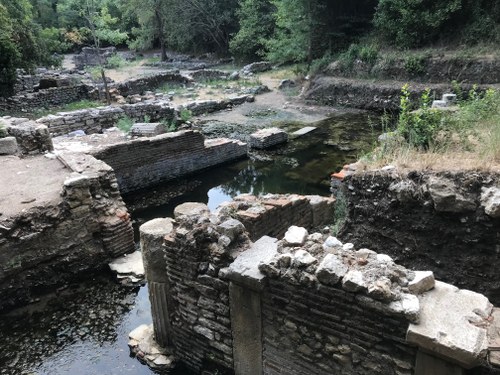
Roman Forum
Its first traces, the northwestern pavement and portico, were found in 2005 by D. Hernandez. The construction of the Forum began after the deduction of Butrint as colony first in 44 BC and then under Augustus, when the previous Agora and its buildings were destroyed or incorporated in the new Forum. The area of the Forum is not a perfect rectangle because of the presence of the South Stoa I underneath, to which it was adapted.
The pavement covers an area of 20 x 72 m, it is made of white limestone rectangular slabs coming from the Acroceraunian Mountains. This area was originally lined on its four sides by an ambulatory approached by two steps. Along the northern side, three steps were added to the original two during the reconstruction of the 2nd century AD.
Traces of four monuments were discovered on the forum pavement. The largest was a base in opus testaceum filled with rubble. It occupied the space in front of Room 2 and 3 of the Tripartite Building and it was probably a podium to support a large statue.
The depth of the deposits from the surface to the level of the forum pavement ranges from two to three meters. The water logged deposits have preserved organic material very well, in fact wood objects, seeds, charcoal, hairs, leather, textiles were recovered. Many coins were found as well, showing strong links with Corcyra. It seems that it was the mint of the city the biggest producer of the small change found in the Forum, even though the coinage itself was sporadic.
The latest occupation of the Forum was in the 16th century, however the recovery of some Mezza-Maiolica shreds shows that the area was still frequented in some was until the beginning of the 17th century.
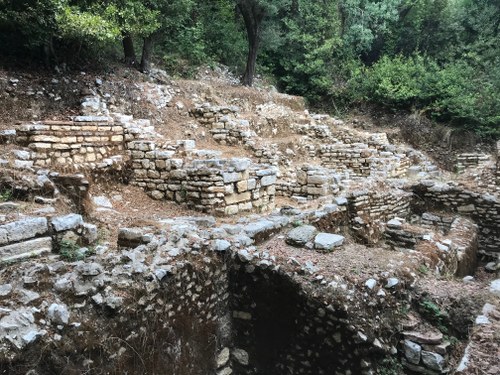
South Portico and tabernae
Before the early 2nd century AD, South Stoa II was demolished and the area became a broad portico separating the forum from the tabernae, built as the northern rooms of the Fountain Complex, initially interpreted as Gymnasium. This portico was paved with cocciopesto. At the western end of the Forum there was a drain, which expelled water from an unknown building into the Forum gutter. A larger drain was also found beneath the floor in the same area, running northwest to southeast.
NW Building (Curia)
Most of the Curia has not been excavated, however part of its layout is still visible: it seems that the building was formed by a single room. It was where the decuriones of the city met.
Bibliography on the subjects
- Adby R., “Butrint, Albania: The coins from the modern excavations in the forum: part 1” in CNNB Newsletter, n. 42, 2007-2008, pp. 1-3
- Adby R., “Butrint, Albania: The coins from the modern excavations in the forum: part 2” in CNNB Newsletter, n. 43, 2008, pp. 1-3
- Adby, R. "Monuments, myth and small change in Buthrotum (Butrint) during the Early Empire." in The City and the Coin in the Ancient and Medieval Worlds, Oxford, 2012, pp. 91-101.
-
Aleotti N., "Rapporti fra Phoinike e Butrinto: le produzioni ceramiche ellenistiche", in De Maria, Gjongecaj (a c.), Phoinike VI Rapporto preliminare sulle campagne di scavi e ricerche 2011-2014, Bologna 2015, pp.101-104
-
Aleotti N., "Rhodian Amphoras from Butrint (Albania): Dating, Contexts and Trade", in JHP 2, 2017, pp. 3-19
-
Aleotti N., Bolzoni G., "Contatti commerciali nel basso Ionio tra l'età ellenistica e l'età imperiale: i dati delle anfore da Butrinto" in Lamboley, Perzhita, Skenderaj, L'Illyrie méridionale et l'Épire dans l'Antiquité. VI. Actes du VIe colloque international de Tirana (20-30 mai 2015), vol. II, Paris, 2018, pp. 791-796
-
Bowden W., "Butrint and Nicopolis: Urban Planning and Romanization of Greece and Epirus" in Hansen, Roman Butrint. An assessment, Oxford, 2007, pp. 189-209
- Bowden W., Mitchell J., "The Christian topography of Butrint" in Hodges, Bowden and Lako, Byzantine Butrint: excavations and surveys 1994-99, Oxford, 2004, pp. 104-125
- Çondi D. e Hernandez D. R., “The Roman forum at Butrint and the development of the ancient urban centre” in Lamboley, Castiglioni (a c.), L’Illyrie méridionale et l’Epire dans l’Antiquité V. Actes du Ve colloque International de Grenoble (10-12 Octobre 2008), 2 volumi, De Boccard, 2010, pp. 243-257
- Hansen I. L., Butrinti helenistik dhe romak. Hellenistic and Roman Butrint, London - Tirana, 2009
- Hernandez, D., & Çondi, D. "The Roman forum at Butrint (Epirus) and its development from Hellenistic to mediaeval times", in Journal of Roman Archaeology, vol. 21, 2008, pp. 275-292.
- Hernandez D. R.e Çondi D., “The formation of Butrint: new insights from excavations in the Roman forum” in Proceedings of the international congress of Albanian archaeological studies. 65th anniversary of Albanian Archaeology (21-22 November, Tirana 2013), Tiranë, 2014, pp. 285-301
- Hernandez D. R. e Çondi D., “The agora and the forum at Butrint: a new topography of the ancient urban center” in Lamboley, Perzhita, Skenderaj, L'Illyrie méridionale et l'Épire dans l'antiquité 6. Actes du 6e colloque international de Tirana (20 - 23 mai 2015), Paris, 2018, pp. 1-17
- Hernandez D. R., "Excavations of the Roman Forum at Butrint (2004-2007): The Archaeology of a Hellenistic and Roman Port in Epirus", PhD Dissertation at the University of Cincinnati, 2010
- Hernandez D. R., "Battling water: the frontiers of archaeological excavation at Butrint (1928-2014)", in The Annual of the British School at Athens, 2017, pp. 1-34
- Hernandez D. R., "Bouthrotos (Butrint) in the Archaic and Classical Periods: The Acropolis and Temple of Athena Polias" in Hesperia, vol. 86, n, 2, 2017, pp. 205-271
- Hernandez, D. R., "Buthrotum's sacred topography and the imperial cult, I: the west courtyard and pavement inscription" in Journal of Roman Archaeology, vol. 30, 2017, pp. 38-63
- Hernandez D. R., "The abandonment of Butrint. From Venetian enclave to Ottoman backwater" in Hesperia, vol. 88, 2019, pp. 365-419
- Piazzini G., "Epirote common wares, cooking wares and amphorae from late antique Butrint", in Lamboley, Perzhita, Skenderaj, L'Illyrie méridionale et l'Épire dans l'Antiquité. VI. Actes du VIe colloque international de Tirana (20-30 mai 2015), vol. II, Paris, 2018, pp. 647-651
-
Pojani I., “The Monumental Togate Statue from Butrint” in Hansen, Hodgens, Roman Butrint: An Assessment, Oxford, 2007, p. 17-32
- Rinaldi E., Agorai ed edilizia pubblica civile nell'Epiro di età ellenistica, Bologna, 2020, pp. 46-55